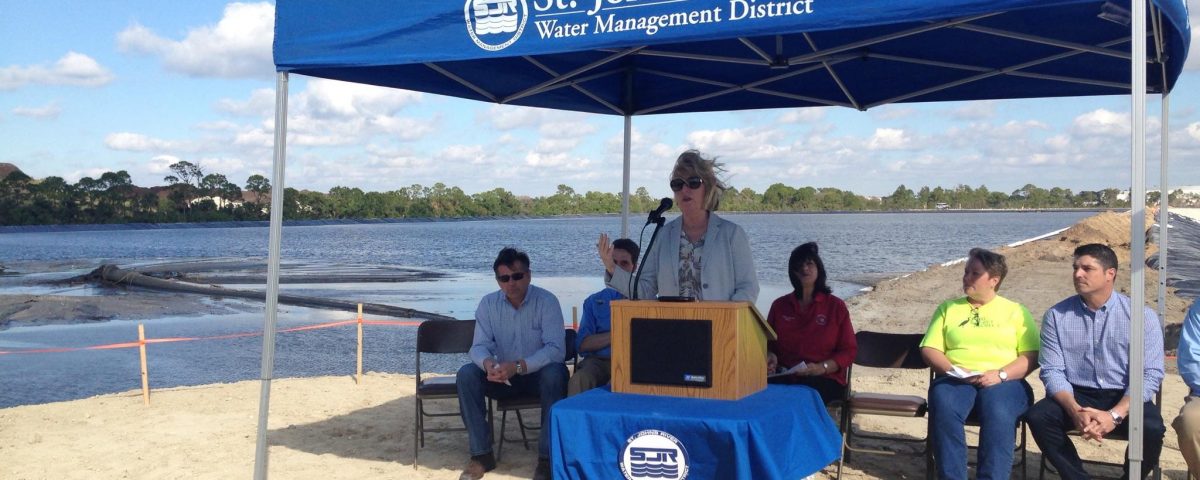District, partners celebrate a cleaner Eau Gallie River

District Executive Director Dr. Ann Shortelle speaks at today’s celebration marking the commencement of dredging of the Eau Gallie River.
PALM BAY, Fla., Feb. 16, 2017 — The St. Johns River Water Management District, Florida Department of Environmental Protection, state and local elected officials, and Indian River Lagoon protection advocates celebrated the commencement of muck dredging from the Eau Gallie River today at Ballard Park in Melbourne.
“This project exemplifies the progress possible in improving conditions in the Indian River Lagoon through partnerships,” said St. Johns River Water Management District Executive Director Dr. Ann Shortelle. “This was a grass-roots effort led those living along the river and supported by the state and Legislature.”
“Indian River Lagoon restoration is a top priority of the department with hundreds of millions already invested in pollution control and more to come,” said Drew Bartlett, DEP deputy secretary for ecosystems restoration. “Everyone is pulling for a healthy Lagoon and we are doing our part by eliminating pollution sources like muck deposits. We are proud to partner with the St. Johns River Water Management District, and Brevard County, to remove muck buildup and improve the overall health of the lagoon.”
Attendees watched as a fantail of muck sprayed from a pipe and into the Dredged Material Management Area. When the project wraps up by late 2018, at least 632,000 cubic yards of the black, gooey substance will be removed. Muck is a mix of fine-grained sediments, sand, clay and organic matter in untreated stormwater runoff that drains to canals and storm drains connected to tributaries in the lagoon, including the Eau Gallie River. Muck can accumulate nutrients that contribute to algal blooms and create detrimental conditions for seagrasses and organisms vital to the lagoon’s aquatic food chain.
“Advancing restoration efforts for the Indian River Lagoon watershed is a top priority of the department with hundreds of millions already invested in pollution control,” said Bartlett. “We are proud to partner with the St. Johns River Water Management District in this project. This is another step forward in tackling the critical water quality issues in the Indian River Lagoon and its tributaries.”
“Waterways like the Eau Gallie River are foundational to the health of Florida’s ecosystem and economy,” said former House of Representatives Speaker Steve Crisafulli of Merritt Island. “It is an honor to advance policies and support funding to protect and preserve our environment.”
“The Florida Legislature’s appropriation for dredging in the Indian River Lagoon and the Eau Gallie River is an important step,” said Rep. Thad Altman of Melbourne. “We want to see the Indian River Lagoon alive, productive and healthy, which will take a multifaceted approach that includes everyone.”
“The district has a long history of partnering with other agencies on large-scale dredging projects in lagoon tributaries,” said District Governing Board Chairman John Miklos. “We are so pleased in an historic event for the Eau Gallie River, which has never been dredged before.”
“We are excited to be part of a project that provides improvements to navigation and water quality in the Eau Gallie River,” said Jerry Sansom, Florida Inland Navigation District Brevard County Commissioner. “This is a dredging project that area residents and legislators rallied together to make happen.”
Stakeholders in attendance included Eau Gallie River Environment is Threatened (EGRET) Project members, who have focused for several years on securing support and funding to improve the conditions of the Eau Gallie River and Indian River Lagoon.
Funding partners include DEP, which is providing $20 million approved by the Florida Legislature in 2014 and 2015; FIND, which contributed $3.9 million toward project design, permitting and construction of a Dredge Material Management Area (DMMA); and the city of Melbourne, which contributed $50,000 for the initial feasibility study.
Dredging is expected to be completed by the end of 2018.

